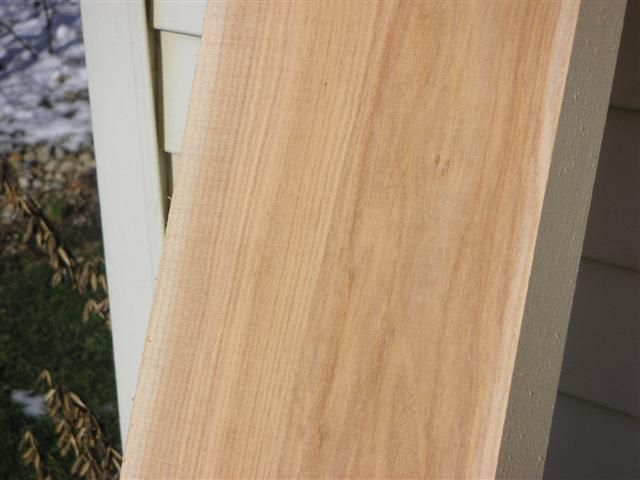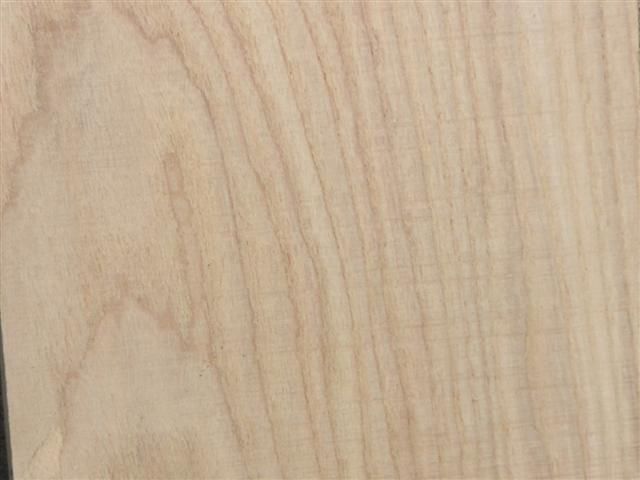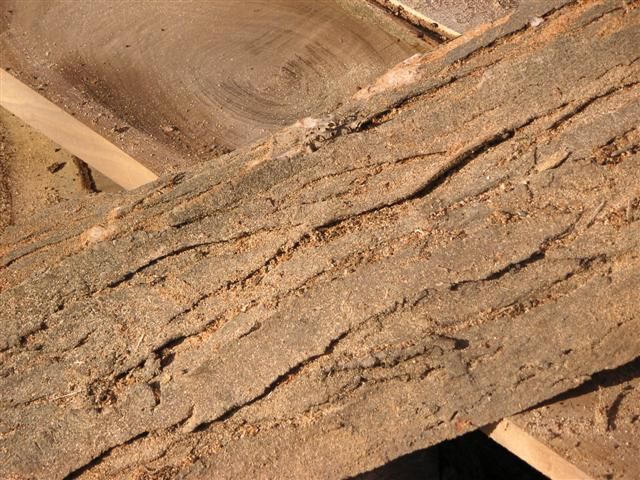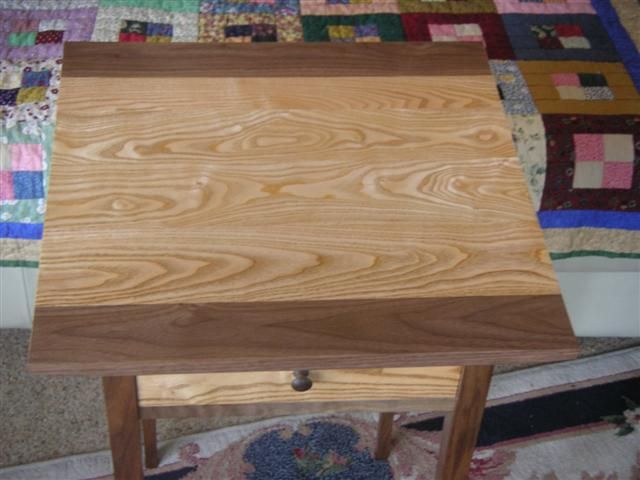Distinguishing Honey Locust and Black Locust
Other Versions
Spanish
They're both beautiful and valuable woods — here's an extended discussion on how to tell them apart. May 11, 2005
Question
I just cut up 600 bd ft of 8/4 honey locust. I will be starting up my DH kiln tomorrow and was wondering about the SDR for the wood. I'm assuming it is honey locust, not black locust. The logs measured 33" in diameter and most of the slabs are 18" to 22" wide. The logs were coated with AnchorSeal immediately after they were felled about 4 months ago. They look beautiful... I don't want to ruin them in my kiln.
Forum Responses
(Sawing and Drying Forum)
From contributor C:
Honey locust is red, black locust is yellow.
From the original questioner:
Here is a picture of a sample of the wood I cut. Can you tell if it is honey locust or black locust?

Click here for full size image
The other side:

Click here for full size image
Sample of the bark side:

Click here for full size image
From Gene Wengert, forum technical advisor:
Honey locust and black locust are not related species... different genus. My vote based on the picture is black locust.
From the original questioner:
Thanks. So it is Robinia pseudoacacia. The guys who cut it down were not sure which it was. Do you have a recommendation on the SDR for black locust?
From contributor R:
Bark pictured is honey locust. 100% sure.
From the original questioner:
I'm getting confused! The bark pictured is from the wood pictured, as well. So it is Gleditsia triacathos.
From contributor R:
Not to confuse you more, but the bark could be Kentucky coffee tree. The wood matches also. It is not black locust.
From the original questioner:
I have a huge Kentucky coffee bean tree in my yard, so I know it is not a KCBT. The bark on the KC is more attached than the bark on this locust tree.
From contributor D:
Did the tree have thorns on it? If so, how big were the thorns? Honey locust has bigger thorns.
From contributor L:
My vote is black locust. That is right about thorns. Honey locust thorns are 3 to 6 inches long, while black locust thorns not very long. Unlike some people, I like sawing the stuff.
From contributor B:
Put me down for honey locust. Black locust bark is more furrowed. Honey locust wood is, well, honey colored. Black locust is light green at first, turning golden when exposed to the sun.
From the original questioner:
I didn't see the tree before it was cut, unfortunately. I'm going to do a bit more research and see if I can solve the mystery.
From Gene Wengert, forum technical advisor:
Send me a piece of wood about the size of a cigarette pack and I will solve the mystery.
From the original questioner:
Dr. Wengert, I will send it out on Monday.
From contributor K:
It is not a coffee tree. This is black locust, Robinia pseudoacacia, also known as yellow locust. Given the size of the board, it could not possibly be clammy locust, which is also in the Robinia family and inhabits much of the same range. The honey locust, Gleditsia triacanthos, has many more thorns on the bark and the thorns get up to 8" in clusters of three. The black locust has smaller thorns.
From contributor G:
I'm not sure if this is honey locust or black locust. But I've had several honey locust logs milled, and not all honey locust has thorns on the trunk. There is significant variation in thorns (some honeys are even naturally thornless), so I don't think the absence of thorns in the picture necessarily determines identification. From the picture of the bark, my guess is that this is honey locust.
From contributor K:
The inclusions on the bark are deeper than the image seems to indicate. I have sawn lots of locust and I stand by my assessment of black locust. What part of the country are you located? The diameter of the trunk is in the correct range. Thornless trunks do occur, but usually only if specifically cultivated and very rarely in the wild.
From contributor B:
Re: SDR for 8/4 Honey Locust Brad S. 12/5
I live in upstate New York and have several honey locusts in the yard. There are no thorns on the trunk and it in fact looks just like the photo in the original post.
From contributor K:
I still think it's black locust. The normal range for honey locust extends through Ohio into some of Pennsylvania and down to Texas. Black locust has been introduced as far as Maine to California, due to useful properties as fence posts (many of the fence posts on our farm were put there by my great grandfather 75 years ago and are still intact). I have made Adirondack chairs from black locust and if you were sunbathing outside and a nuclear blast went off in the distance, your ashen figure would be silhouetted onto the still intact locust chair. Stuff is like steel once dried and lasts just as long.
From contributor O:
Honey locust. Some of the trees have thorns, and a smooth bark almost like cherry. Other varieties have no thorns, like the bark pictured. Wood is definitely honey locust. I took about 2,000 bd. ft. off the farm a couple years ago. Both types of trees as well - thorns, and no thorns.
From the original questioner:
I have two samples on the way to Dr. Wengert. I checked Bruce Hoadley's "Indentifying Wood" p. 111. Black locust has many tyloses (p. 35), whereas honey locust has none. I'm looking at the end grain cut with a very sharp LA block plane, and with a 5x it looks like honey locust.
From contributor Z:
Kudos to you for researching the wood - I'd bet good money you are correct. As others have said, not all HL trees have thorns. When you are responsible for tree ID, it will throw you for a loop until you learn this, wild HL included. Some of the mature HL's bark will turn 90 degrees to a ridge. This bark characteristic is noted on the pic you provided.
From contributor M:
Native honey locust (gleditsia tricanthos) has many spiny thorns, however most cultivars (cultivated varieties) are thornless. Many are commonly planted throughout the
U.S. When sawn up, the wood looks the same as native spiny honey locust.
From contributor E:
I am positive that the top picture is honey locust. I am in eastern Iowa and honey locust seems to be much more common, at least in my experience. HL is a beautiful wood; the sapwood is a bright yellow and the heart is light brown with swirls of dark red. I agree that many HL trees do not have thorns on them, so you can't always use that as an ID tool. I would say the bark looks right for HL, but I have a very tough time with bark. BL looks more brown/gray when cut, and lacks the dark red streaks. Also, HL has a distinctive odor - it's very pleasant, but difficult to describe. You can tell black and honey locust from KCBT with fluorescence, the locust's fluoresce bright yellow and I don't believe KCBT fluoresces at all. (Am I remembering correctly, Dr. Gene?)
From contributor K:
Well, we have narrowed it down to a locust tree :) I looked at a honey locust on our farm and the bark does look like the one in the photo, so I recant my earlier assessment of black locust and go with the honey locust.
From contributor X:
The best way to identify the tree is from the leaves or fruit. Honey mesquite looks a lot like what you have shown. Can be confused with honey locust.
From contributor U:
I own river bottom in Iowa and have more scars from honey locust than I care to admit. Use the black light approach. Honey locust will turn a beautiful bright yellow. The sawdust will also stand out in your shop and tell you how really dirty it is.
From contributor Q:
Yep, it's honey locust. We saw a fair amount of it in central Iowa. On our farm we have some that are almost completely thornless and others that are covered with 'em. It is a much underappreciated wood and grows like a weed here. The ones covered with thorns have a very distinctive pattern I call cat prints on the wood cut very close to the bark.
From contributor J:
Since we're on the topic, let me ask the locust experts what I am cutting. They are definitely locusts, the thorns are generally 4-6 inches long, the bark looks as pictured above, and the wood is a very bright pink/peach color when freshly sawn. Also, the bugs will turn it into dust in no time if precautions are not taken. When I look around the web, these long thorned trees are usually (not all places agree) called honey locusts, but the wood color does not match what is generally described. I have cut many of these trees, and the wood is always a very bright pink/peach color - very similar to that of the Kentucky coffee tree when fresh sawn. Anyone?
From contributor E:
Sounds like honey locust to me. KCBT does not have thorns, to the best of my knowledge. Those bugs would be the locust borer (Megacyllene robiniae); they are black with yellow markings.
From contributor L:
Well, after a much closer second look, I have decided to change my opinion. The bark is definitely honey locust, but the wood is black locust. This is a fairly common mutant in our area called the black honey locust. The mutation was caused by... better not tell... they could still be around.
From Gene Wengert, forum technical advisor:
The wood samples are honeylocust. You can take this identification to the bank. (Correct spelling of HL is one word.)
From contributor T:
Honeylocust that I've cut here in northeast Kansas has heartwood that is a salmon color when fresh cut. It turns more brown as it dries (I've only air dried it, though). On the other hand, Kentucky coffee tree that I've cut here is a dark chocolate brown when fresh cut. It dries to a light brown - about the color of a chocolate milkshake. Both trees grow very well in this part of Kansas, though not necessarily to sizes useful for lumber.
From contributor J:
Well, that's where I am, northeast Kansas, so I'm sure we're dealing with the same thing. I come across a lot of locust in the 18-24" range, which is big enough for me, and like you say, it's a bright salmon when fresh cut. Since they are a pest to the farmers around here, they are usually happy to have me get them out of the way. I've burnt a lot of it for firewood, but only just started milling it. Any suggestions on keeping the bugs from devouring it as it dries? I don't cut enough to warrant a kiln right now, so I just air dry everything, and the bugs seem to love it. We don't have much Kentucky coffee tree around my place, but I've again cut a little dead standing for wood.
From the original questioner:
I've attached a picture of a table from which part is made of Kentucky coffee tree. The wood actually came from large limbs cut off the tree. The tree is huge; probably more than 4' in diameter. The KCT wood is bordered by walnut. It is finished with blonde shellac, so the true character of the wood is revealed.

Click here for full size image
From contributor T:
The problem with honeylocust and Kentucky here isn't the diameter of the tree so much as the height of the first limb. Anyway, I have noticed that the bugs like the honeylocust, too. Once sawn and stickered, though, they don't get into it so much. More precisely, once the MC goes below some value, they don't seem to be interested. I've had most of my problems with logs that have sat a while before cutting.
From contributor J:
I'm with ya on the limbs. In fact, a lot of the trees I've cut have had multiple trunks, probably due to being cut off sometime in the past. They are as bad as hedge if you don't treat the stumps it seems. Good info regarding the bugs. The pieces I was having real problems with were some thick slabs I had cut for a custom bookmatch table project. Luckily, this lady said she liked the holes in the wood, and I think I eventually got the little suckers eradicated. Sounds like next time I would be better off sawing it thinner, drying it faster, then gluing it back together down the road.
The comments below were added after this Forum discussion was archived as a Knowledge Base article (add your comment).
Comment from contributor A:
I have lots of black locust on my property and have taken the trees down to make wood furniture and keepsakes for the kids. I know this wood well. The wood pictured looks nothing like the black locust I work with. Black locust, when cut either quartersawn or flatsawn, shows a nice variation of yellows, blacks, browns, and greens. The wood pictured is just too monotonous to be real black locust. I don't buy it. The bark, too, looks less variegated than the black locust bark. Maybe it's not even honey locust.
Comment from contributor B:
I have worked with both honey locust and black locust trees and the honey locust has a very strong odor when it is cut wet. The black locust does not emit a strong odor. The odor I detect is more pronounced in honey locust wood than in walnut.


